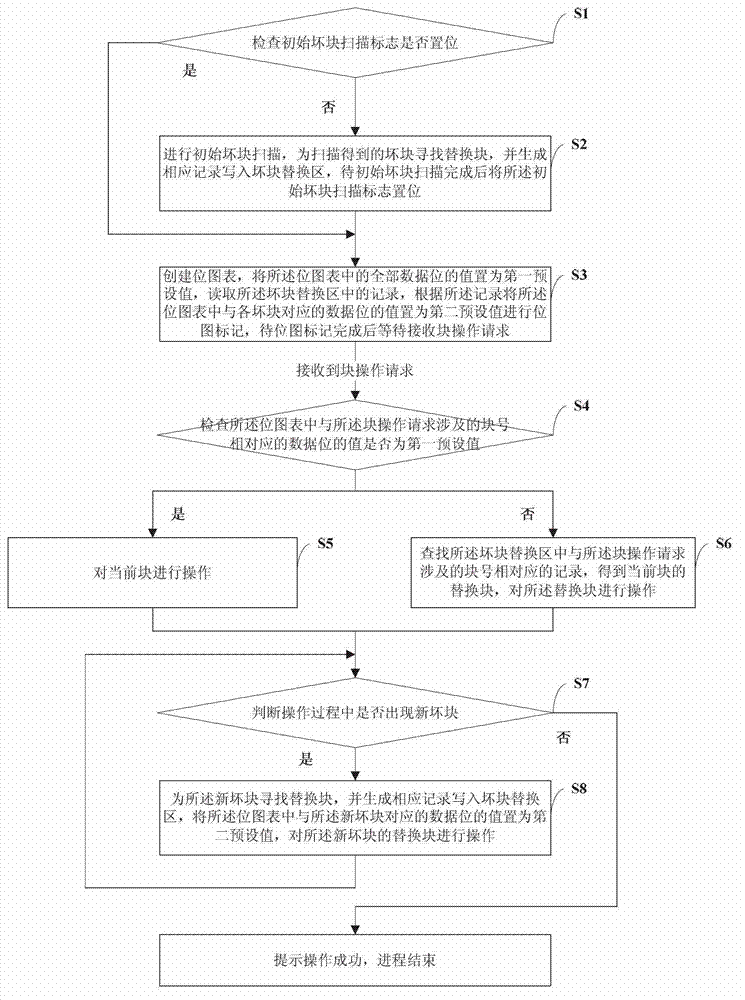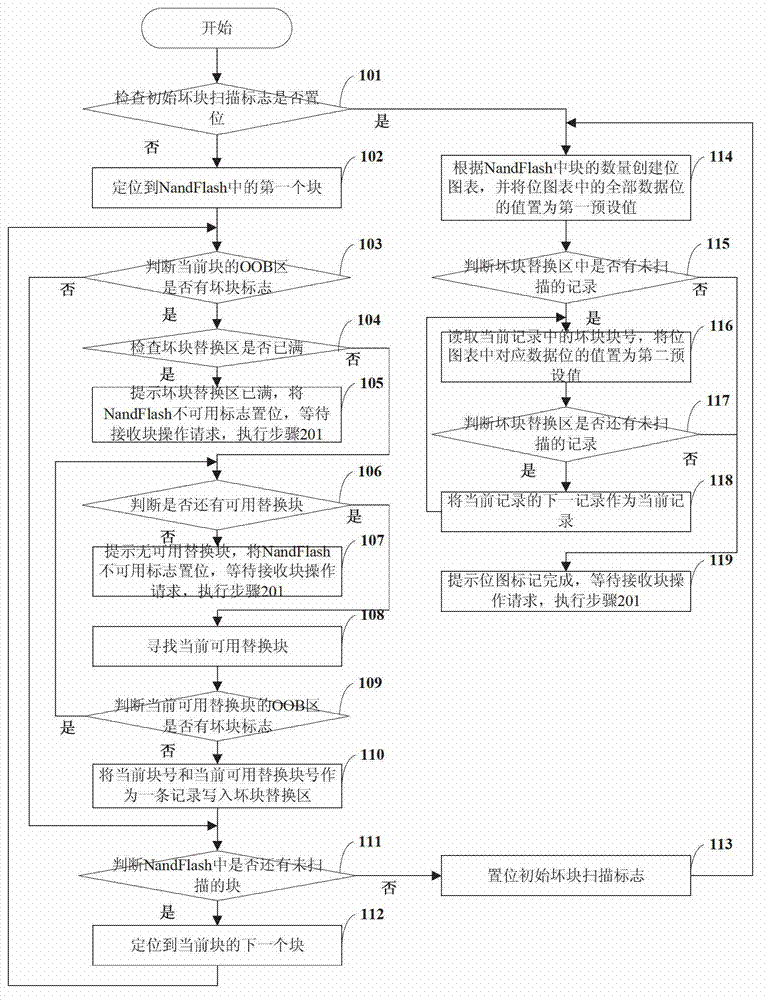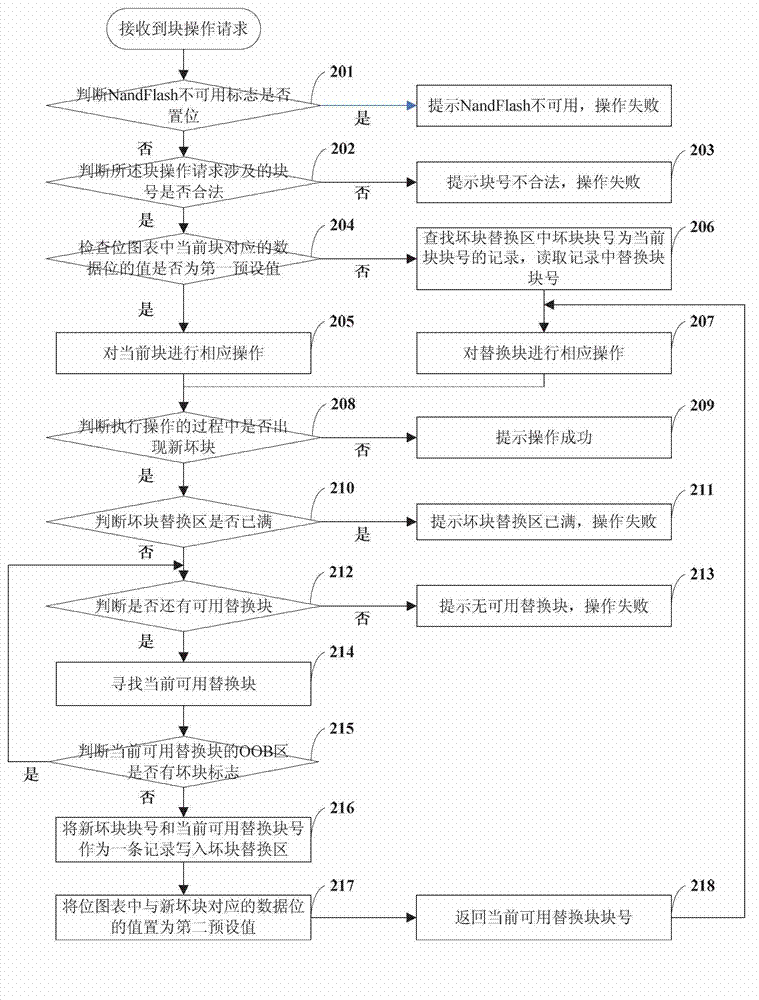NandFlash bad block management method
A bad block and block number technology, applied in the field of NandFlash bad block management, can solve the problems of increased memory capacity and large memory, and achieve the effects of strong adaptability, high production efficiency and strong versatility
- Summary
- Abstract
- Description
- Claims
- Application Information
AI Technical Summary
Problems solved by technology
Method used
Image
Examples
Embodiment 1
[0049] see figure 1 , the embodiment of the present invention provides a kind of NandFlash bad block management method, and described method specifically comprises:
[0050] Step S1: Check whether the initial bad block scanning flag is set, if yes, directly execute step S3, otherwise execute step S2;
[0051] Step S2: Perform an initial bad block scan, find a replacement block for the scanned bad block, generate a corresponding record and write it into the bad block replacement area, and set the initial bad block scan flag after the initial bad block scan is completed;
[0052] Step S3: Create a bitmap, set the values of all data bits in the bitmap to the first preset value, read the records in the bad block replacement area, and compare the information in the bitmap according to the records. The value of the data bit corresponding to each bad block is set as the second preset value to carry out bitmap marking, and waits to receive a block operation request after the bitmap m...
Embodiment 2
[0064] The embodiment of the present invention provides a kind of NandFlash bad block management method, described method specifically comprises four parts of initial bad block scanning, bitmap creation and mark, block operation and bitmap update, present embodiment respectively initial bad block scanning and Bitmap creation and marking as a process, block manipulation and bitmap update as a process are described.
[0065] see figure 2 , the process of initializing bad block scanning and bitmap creation and marking includes the following steps:
[0066] Step 101: Check whether the initial bad block scanning flag is set, if yes, execute step 114, otherwise execute step 102;
[0067] Wherein, the initial bad block scanning flag is used to identify whether the initial bad block scanning is completed, and the initial scanning flag is in a reset state when the NandFlash leaves the factory, and is set when the initial bad block scanning is completed.
[0068] Step 102: locate the...
Embodiment 3
[0117] The embodiment of the present invention provides a kind of NandFlash bad block management method, described method specifically comprises four parts of initial bad block scanning, bitmap creation and mark, block operation and bitmap update, present embodiment respectively initial bad block scanning and Bitmap creation and marking as a process, block manipulation and bitmap update as a process are described.
[0118] The process of initial bad block scanning and bitmap creation and marking is the same as the method in Embodiment 2, and will not be repeated here;
[0119] see Figure 4 , the block operation and bitmap update process includes the following steps:
[0120] Step 301: When receiving a block operation request, check whether the NandFlash unavailable flag is set, if so, it will prompt that NandFlash is unavailable, and the operation fails, otherwise step 302 is performed;
[0121] Step 302: Judging whether the block number involved in the block operation requ...
PUM
 Login to View More
Login to View More Abstract
Description
Claims
Application Information
 Login to View More
Login to View More - R&D
- Intellectual Property
- Life Sciences
- Materials
- Tech Scout
- Unparalleled Data Quality
- Higher Quality Content
- 60% Fewer Hallucinations
Browse by: Latest US Patents, China's latest patents, Technical Efficacy Thesaurus, Application Domain, Technology Topic, Popular Technical Reports.
© 2025 PatSnap. All rights reserved.Legal|Privacy policy|Modern Slavery Act Transparency Statement|Sitemap|About US| Contact US: help@patsnap.com



